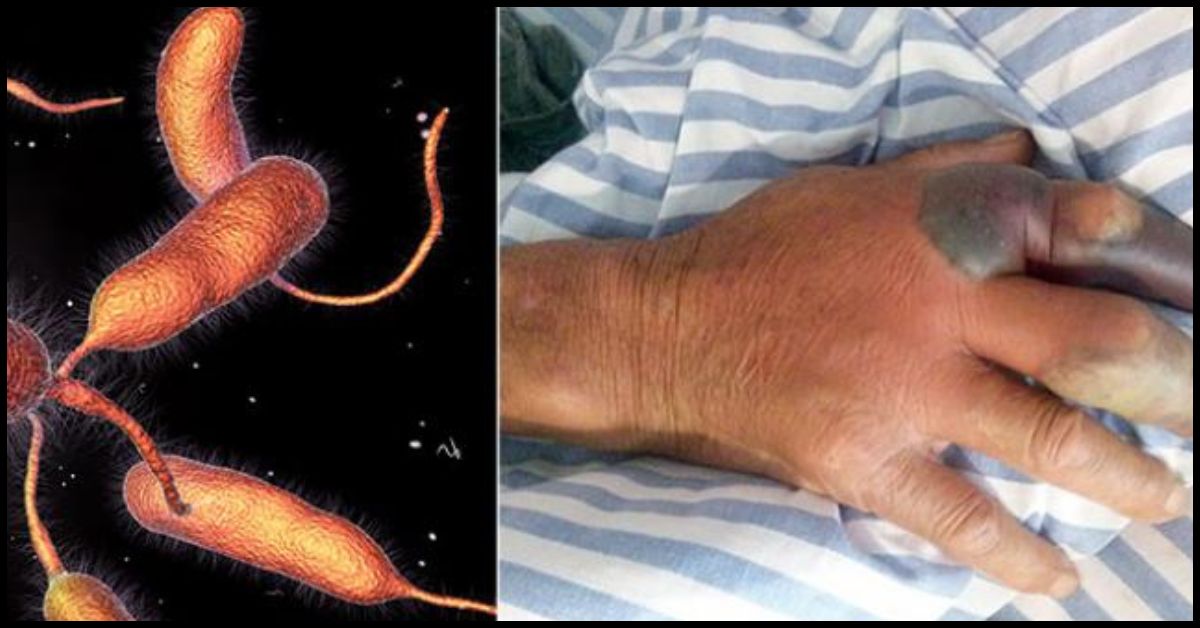Flesh Eating Bacteria Florida In 2025, a alarming health concern has emerged in the United States, particularly in Florida, where a rare but deadly bacteria known as Vibrio vulnificus—often referred to as “flesh-eating bacteria”—has caused a spike in infections and fatalities.

As of July 11, 2025, the Florida Department of Health (FDOH) reported 11 confirmed cases of Vibrio vulnificus infections, resulting in four deaths across Bay, Broward, Hillsborough, and St. Johns counties. This article provides a detailed overview of the bacteria, its impact in 2025, symptoms, risk factors, prevention strategies, and treatment options, offering critical information for U.S. residents, especially those in coastal areas.
What is Vibrio vulnificus?
Vibrio vulnificus is a naturally occurring, salt-loving (halophilic) bacterium found in warm, brackish seawater—a mix of fresh and saltwater commonly found in estuaries, coastal waters, and areas where rivers meet the sea.

While it is one of several Vibrio species that can cause human illness (vibriosis), Vibrio vulnificus is particularly dangerous due to its potential to cause severe, life-threatening infections, including necrotizing fasciitis, a condition that rapidly destroys skin and soft tissue, earning it the “flesh-eating bacteria” nickname. However, experts clarify that the term is misleading: the bacteria does not “eat” flesh but releases toxins that kill tissue around an infected wound.
Nationwide, Vibrio vulnificus and other Vibrio species cause an estimated 80,000 illnesses and 100 deaths annually, according to the Centers for Disease Control and Prevention (CDC). Florida, with its warm climate and extensive coastline, reports the highest number of cases in the U.S., particularly during summer months when water temperatures peak and hurricane-related flooding increases brackish water exposure.
The 2025 Outbreak – Flesh Eating Bacteria Florida
Case Statistics
As of July 11, 2025, the FDOH documented 11 cases of Vibrio vulnificus infections in Florida, with four fatalities reported in the following counties:
- Bay County: 1 death
- Broward County: 1 death
- Hillsborough County: 1 death
- St. Johns County: 1 death
Additional cases have been reported in counties like Manatee, Escambia, Santa Rosa, and Duval, with St. Johns County noting two cases, one fatal. While the FDOH has not specified the exact sources of these infections, the bacteria is typically contracted through exposure of open wounds to brackish water or consumption of raw or undercooked seafood, particularly oysters.
Context and Contributing Factors
The 2025 surge follows a pattern observed in previous years, where hurricane activity exacerbates the spread of Flesh Eating Bacteria Florida. In 2024, Florida reported a record 82 cases and 19 deaths, largely attributed to flooding from Hurricanes Helene and Milton, which spread brackish water into inland areas. Similarly, in 2022, Hurricane Ian led to a spike in cases in Collier and Lee counties. The 2025 cases may be linked to residual environmental conditions from prior storms or new weather events, as flooding creates ideal conditions for the bacteria to thrive.
Experts, including Dr. Kami Kim from Tampa General Hospital, note that Florida’s growing population, including newcomers unfamiliar with local water risks, contributes to increased infections. Warmer ocean temperatures, potentially linked to climate patterns, also enhance the bacteria’s proliferation, making coastal areas more hospitable to Vibrio vulnificus.
Symptoms of Vibrio vulnificus Infection
Flesh Eating Bacteria Florida infections manifest in two primary forms: wound infections and gastrointestinal illness from seafood consumption. Symptoms vary depending on the infection type and can escalate rapidly, especially in high-risk individuals.
Wound Infections
When the bacteria enters through an open wound (e.g., cuts, scrapes, or surgical sites) exposed to brackish water, it can cause:
- Redness, swelling, and severe pain at the wound site
- Blistering skin lesions or ulcers
- Fever and chills
- Discharge or oozing from the wound
- Necrotizing fasciitis, a severe condition where tissue around the wound dies rapidly, potentially requiring amputation
If the bacteria invades the bloodstream, it can lead to:
- Septic shock (dangerously low blood pressure)
- Fever and chills
- Blistering skin lesions across the BODY
- Confusion or disorientation
Bloodstream infections are fatal in about 50% of cases, with death sometimes occurring within 24–48 hours of symptom onset.
Gastrointestinal Infections
Ingesting Vibrio vulnificus through raw or undercooked shellfish, particularly oysters, can cause:
- Watery diarrhea
- Stomach cramping
- Nausea and vomiting
- Fever
In severe cases, gastrointestinal infections can progress to bloodstream infections, especially in immunocompromised individuals, leading to the same life-threatening symptoms as wound infections.
Risk Factors
While anyone can contract Vibrio vulnificus, certain groups are at higher risk for severe outcomes:
- Immunocompromised individuals: Those with chronic liver disease (e.g., cirrhosis), kidney disease, diabetes, or weakened immune systems (e.g., from cancer or HIV) are up to 80 times more likely to develop severe infections.
- People with open wounds: Fresh cuts, scrapes, or recent tattoos/piercings increase susceptibility when exposed to contaminated water.
- Seafood consumers: Eating raw or undercooked shellfish, especially oysters harvested from warm coastal waters, poses a significant risk.
Prevention Strategies
Preventing Vibrio vulnificus infections requires vigilance, particularly in coastal regions like Florida. The FDOH and CDC recommend the following steps:
Avoiding Water-Related Infections
- Stay out of brackish or saltwater with open wounds: Avoid swimming, wading, or working in warm coastal waters or floodwaters if you have fresh cuts, scrapes, or surgical wounds.
- Wear protective gear: Use gloves, waders, or waterproof footwear when handling raw shellfish or working in brackish water to prevent cuts from rocks, shells, or fishing equipment.
- Clean wounds immediately: If a wound is exposed to seawater, brackish water, or raw seafood juices, wash it thoroughly with soap and clean water and disinfect it promptly.
- Monitor for infection: Seek immediate medical attention if a wound shows signs of infection (redness, swelling, pain, or oozing) or if you develop fever, chills, or other systemic symptoms after water exposure.
Safe Seafood Consumption
- Cook shellfish thoroughly: Boil shellfish (oysters, clams, mussels) until shells open, then continue boiling for 5 minutes, or steam until shells open and cook for an additional 9 minutes. Discard shellfish that do not open during cooking.
- Avoid raw shellfish: Refrain from eating raw oysters or other shellfish, especially if you are immunocompromised.
- Handle seafood safely: Wash hands, utensils, and surfaces after handling raw shellfish, and refrigerate leftovers promptly to prevent bacterial growth.
- Check advisories: Stay informed about local health advisories regarding contaminated waters or shellfish harvesting areas, available through the FDOH or the FDA’s Seafood Hotline (1-800-332-4010).
Post-Hurricane Precautions
- Avoid floodwaters: After hurricanes or heavy storms, avoid contact with floodwaters, which may contain high levels of Vibrio vulnificus due to brackish water spread.
- Be cautious during cleanup: Wear protective clothing and avoid direct contact with floodwater during post-storm cleanup efforts.
Diagnosis and Treatment
Diagnosis
Vibrio vulnificus infections are diagnosed by culturing the bacteria from wound, blood, or stool samples. Healthcare providers should inquire about recent exposure to brackish water or raw seafood, especially in patients with fever, hemorrhagic bullae, or signs of sepsis. Clinical laboratories should submit suspected Vibrio isolates to public health laboratories for confirmation and genomic sequencing.
Treatment
Prompt treatment is critical due to the bacteria’s rapid progression. Treatment includes:
- Antibiotics: Early administration of antibiotics (e.g., doxycycline or ceftazidime) can improve survival rates for both wound and bloodstream infections.
- Wound care: Aggressive wound management, including surgical debridement, may be necessary to remove dead or infected tissue.
- Amputation: In severe cases of necrotizing fasciitis, amputation of affected limbs may be required to halt the infection’s spread.
- Supportive care: Patients with bloodstream infections often require intensive care to manage septic shock and organ failure.
The CDC notes that about 1 in 5 people with Vibrio vulnificus infections die, sometimes within days, underscoring the need for immediate medical intervention.
Public Health Response in 2025
The FDOH and CDC are actively monitoring Vibrio vulnificus cases, with Florida leading national surveillance efforts due to its high case load. Since 2007, Vibrio infections have been nationally notifiable, with Gulf Coast states like Florida, Alabama, Louisiana, Texas, and Mississippi collaborating with the CDC to track cases. Public health measures include:
- Public advisories: The FDOH has issued warnings about avoiding brackish water with open wounds and cooking shellfish thoroughly.
- Post-hurricane alerts: Following storms, health officials emphasize the risks of floodwater exposure, as seen after Hurricanes Helene and Milton in 2024.
- Education campaigns: The CDC provides resources on safe water activities and seafood consumption, urging coastal communities to display signage about Vibrio risks.
The Bigger Picture: Climate and Public Health
The rise in Vibrio vulnificus cases is part of a broader trend linked to environmental changes. A 2023 study found a five-fold increase in Florida’s Vibrio infections between 1992 and 2022, with climate patterns contributing to warmer coastal waters and increased flooding.
NASA and other researchers have noted that rising ocean temperatures create more favorable conditions for Vibrio growth, potentially expanding its range to northern coastal areas like the East Coast and Alaska. This trend highlights the intersection of climate change and public health, urging residents to stay vigilant.
Conclusion
The 2025 Vibrio vulnificus outbreaks in Florida serve as a stark reminder of the dangers posed by this rare but deadly bacteria. With 11 cases and four deaths reported so far, U.S. residents, particularly those in coastal states, must take precautions to avoid infection.
By staying informed, avoiding brackish water with open wounds, cooking shellfish thoroughly, and seeking prompt medical care, individuals can reduce their risk. As environmental factors like hurricanes and warming waters continue to amplify the threat, public awareness and proactive health measures are more critical than ever.

नमस्कार दोस्तों मेरा नाम Yogesh Singh है। मै एक हेल्थ और ब्यूटी एक्सपर्ट हूं जो BeautyGyan.com जैसे बड़े प्लेटफॉर्म पर आसान और असरदार घरेलू नुस्खे शेयर करता हूं हमारा लक्ष्य है – सभी को नेचुरल तरीकों से स्वस्थ और खूबसूरत बनाना धन्यवाद।






